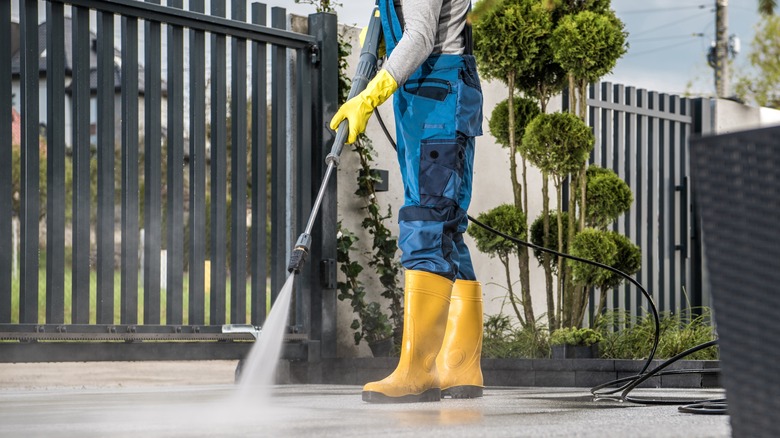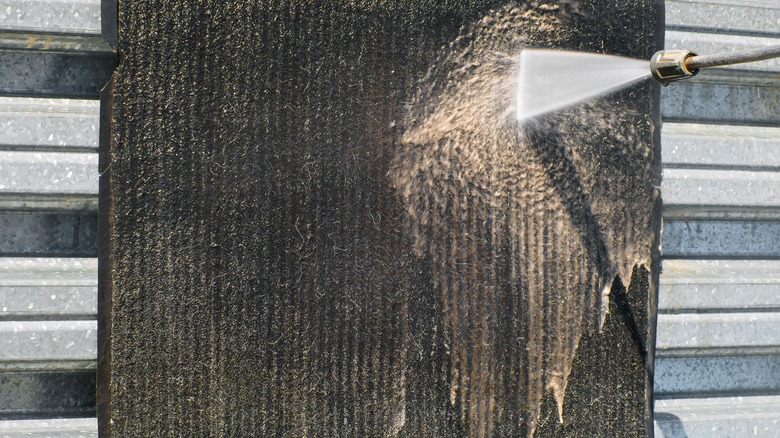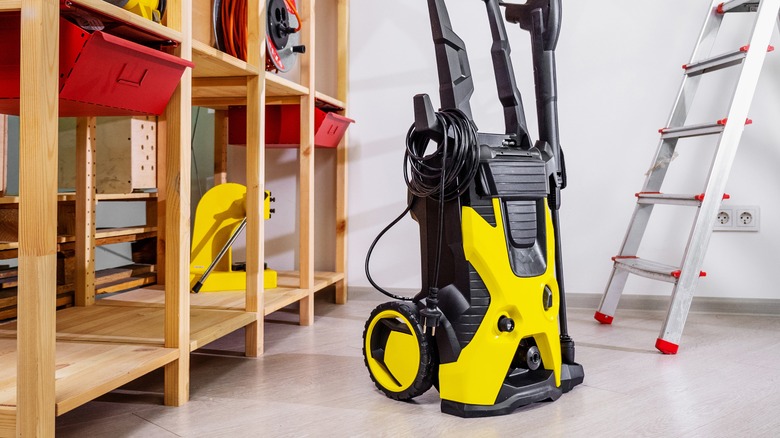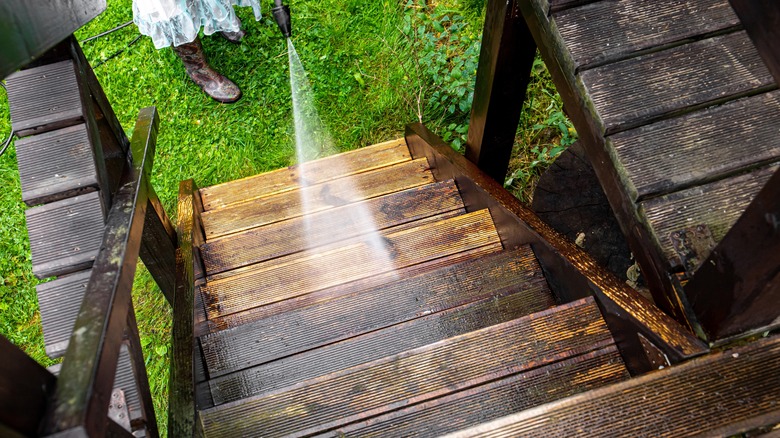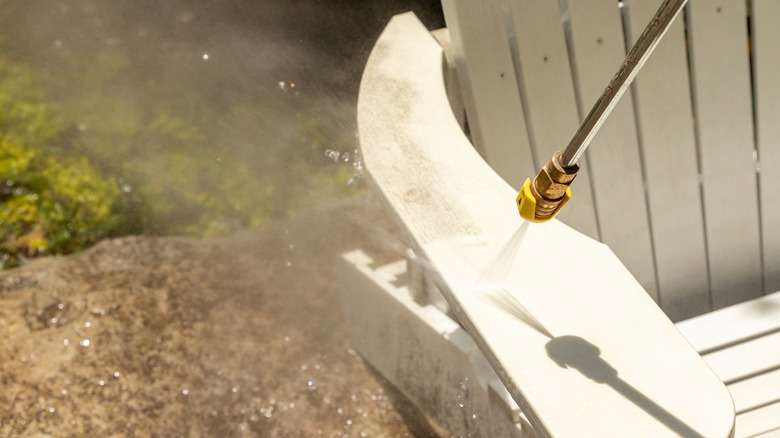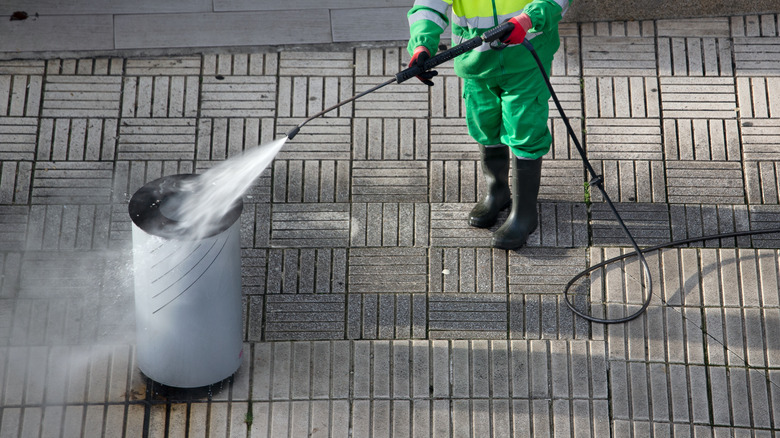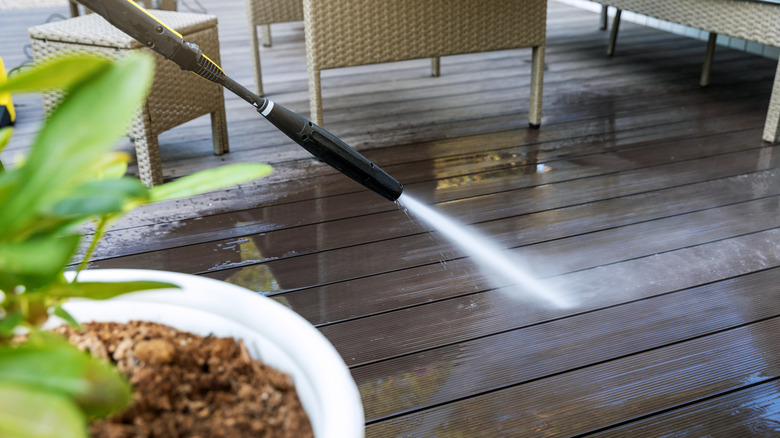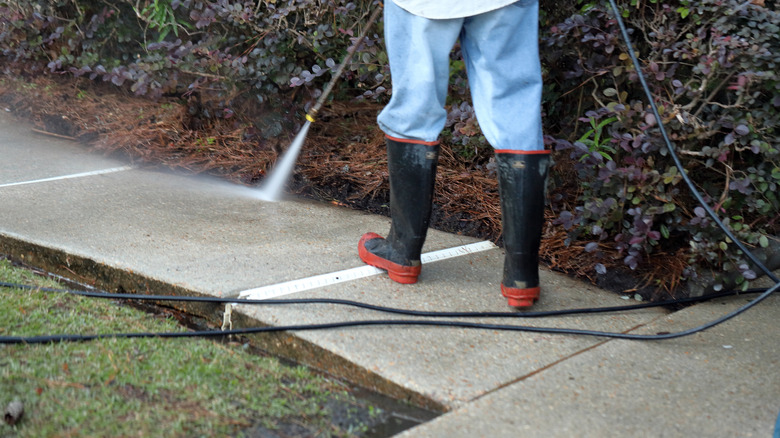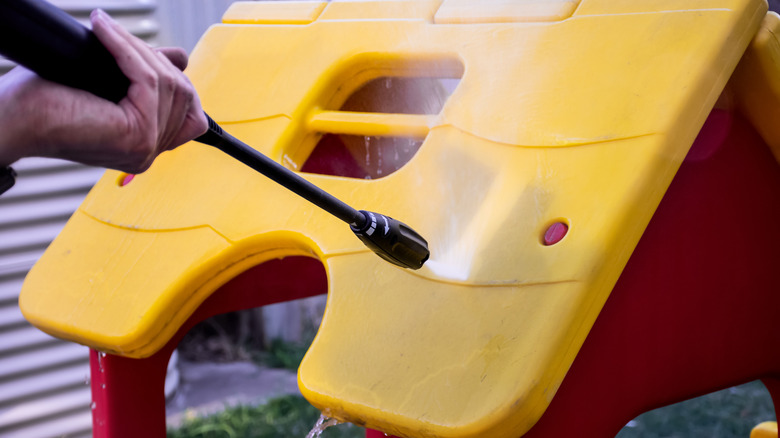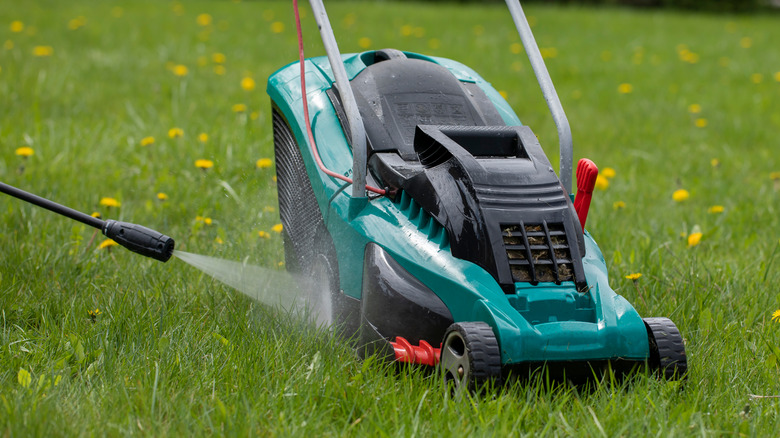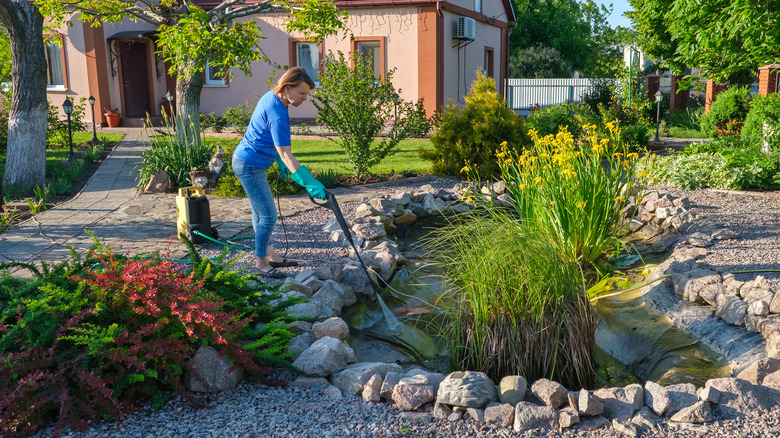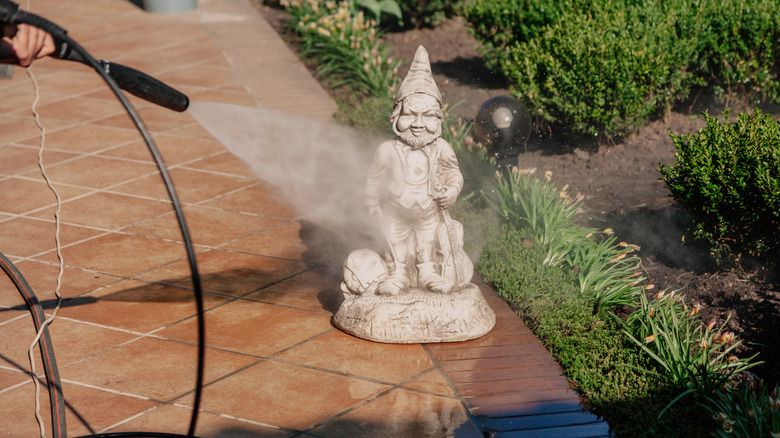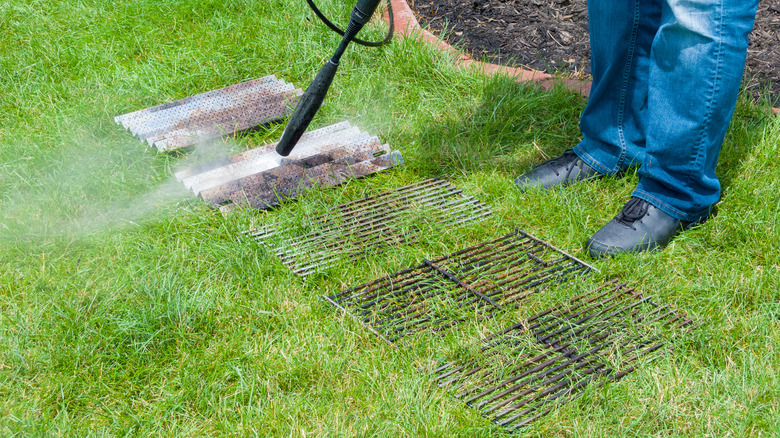Use Your Pressure Washer To Clean These 12 Things For Dazzling Results
There are plenty of practical reasons why you might need to use a pressure washer around the house, but also, it's just a really fun way to clean. Blasting away layers of stubborn dirt and grime with one jet of pressurized water is deeply satisfying to watch. A pressure washer can make quick work of tough cleaning jobs that would otherwise require a lot of elbow grease. It's also safe to use on many items you probably have around your home and yard. While there's a long list of things you should never clean with a pressure washer, the list of things you can clean this way is even longer.
If you've never used a pressure washer before, proceed very cautiously and only after you're done your research. Read the manual for your specific model of pressure washer because they're not all the same. Watch instructional how-to videos to learn how to operate the machine safely and efficiently. Always do pressure washing outdoors. Also, always clear other people or pets out of the area first, because the spray from a pressure washer is stronger than you might anticipate and could cause harm. Perhaps most importantly, always start with the machine set to its gentlest setting. Consumer pressure washers can typically dispense water that's pressurized to anywhere from 500 pounds per square inch (PSI) to 4,000 PSI. Use a lower PSI to start and only turn it up if you're not getting results.
Floor rugs
If you're often anxious, bored, or can't sleep, you might already be among the legion of fans who love watching videos of people pressure washing rugs. Between YouTube and other social media channels, there's a virtually endless stream of these videos out there. Watch them for how-to tips, or just to be soothed. There's just something incredibly satisfying about watching a filthy, neglected rug be transformed. The pressure washer's spray slowly reveals the colors and patterns hidden beneath years of grime. It's an experience you can recreate at home, if you have old or dirty rugs that need really deep cleaning.
There are some caveats before taking on this project. First: certain types of rugs are too delicate. Rugs made of natural fibers such as wool and sisal could be damaged by being soaked with water and/or hit with a pressurized stream of water. Synthetic rugs and outdoor rugs are generally safe for pressure washing; still, check the care instructions before proceeding. Second, you'll need an outdoor area where you can lay out the rug for washing, and a plan for where you're going to let the sopping wet rug air dry. In a stretch of dry and sunny weather, you might be able to leave it outdoors for a few days to dry. Otherwise, think about how you're going to manage the drying process indoors; for example, can you string up a series of clotheslines in a dry garage or basement to hang the rug over?
Garage floors
Deep cleaning the garage floor isn't a standard part of the spring cleaning ritual for most of us. Maybe you've never used anything but a broom to clean the garage floor. Or, you've never actually thought about the condition of that floor until right now. The next time you're out there, take a close look at the dust, cobwebs, yard debris, dried mud, animal fur, and/or random stains littering the floor. Pressure washing is a quick and effective way to clear everything out, and it's safe for most garage floors (with the exception of painted floors).
Granted, pressure washing the garage floor is a big undertaking. The whole space really needs to be empty, so you might do pressure washing as part of a big garage clean-out every few years, or before converting the garage into a living space. Sweep or Shop-Vac the entire floor first so you can pick up things like fallen screws and nails instead of flushing them out with the flow of water. Cover any electrical outlets with plastic covers or tape, or hang tarps over the walls to protect everything there from potential water damage. Are there any significant oil or rust stains on the floors? Think ahead about what kinds of special cleaners you might want to have on hand for spot treating those areas. When you're done, leave the garage doors open to let the space air dry, or speed up the drying process using old towels.
Outdoor stairs
Like garage floors, outdoor stairs might be neglected for years in between cleanings. It's just not an area that people think about when they're looking at what needs to be cleaned around the house and yard. So, power washing your outdoor stairs might yield some pretty striking results — especially if it's been years (or decades) since it was last done. This method can blast away dirt, moss, animal waste, and all the other mysterious debris that builds up on outdoor steps and might even make them dangerously slippery. It would take a lot of time and effort to scrub that stuff away by hand. A pressure washer gets the job done in minutes.
Pressure washing is typically an appropriate way to clean outdoor stairs because they're commonly built from concrete, brick, hardwood, or other materials that can withstand the elements. That said, don't point a pressure washer at crumbling concrete steps, or stairs that have been painted (unless you're actually trying to remove the paint). The easiest way to approach this task is to generally start at the top of the stairs and move down, spraying the nozzle across the tread of each stair, then across the vertical riser below, then the tread of the next stair, and so on.
Outdoor furniture
After a long winter in the dusty garage or after it's been left out in the elements in the backyard, lawn furniture tends to look a little bedraggled. (In other words: covered in cobwebs, dead flies, and mystery stains you'd rather not look too closely at.) During warmer months, outdoor furniture might become unusably dirty from things like pollen, animal waste, and mildew. Pressure washing can be a great way to refresh outdoor loungers, chairs, tables, and more, in a hurry.
Exercise caution, though. This method is best reserved for cleaning lawn furniture made of plastic or metal. (Make sure to remove any fabric cushions from plastic or metal chair frames before using a pressure washer on these pieces of furniture.) It's not a good idea to pressure wash outdoor furniture made from glass, wood, or natural materials like rattan. The force of the pressurized water could warp furniture made from wood or rattan, as well as damage any paint used. And it probably goes without saying, but pressure washing and glass should just never mix. Clean your glass outdoor tables with old-fashioned elbow grease instead.
Garbage cans
It doesn't take long for pristine garbage cans to become grimy, sticky, and stinky. Both indoor and outdoor trash cans need semi-frequent cleaning to keep them from taking on a permanent eau de garbage. Outdoor trash cans may also attract insects and vermin if any organic debris is left in or on them for long. Using a pressure washer to clean the insides and outsides of garbage cans allows you to blast away any lingering debris and mysterious liquids, without getting your hands dirty.
Obviously a pressure washer isn't a good choice for cleaning a decorative wicker trash can, but your durable plastic trash cans should be able to hold up to pressure washing without damage. The same goes for recycling bins. You're probably going to do two rounds of pressure washing on stinky trash cans: one with a cleaning detergent and a second to rinse. Alternatively, you may want to clean really smelly cans by hand with a bleach solution, and follow up with a rinse from the pressure washer. Use a scrubber attachment, if you have one, to get the cans as clean as possible. Empty out any big pieces of garbage from the cans first or you risk getting being hit with flying, wet trash. And prepare to get wet from some blowback when the spray hits the inside of the cans.
Patios and decks
If you're lucky enough to have some patio or deck space, make it as inviting as you possibly can. You're probably going to want to spend more time hanging out there with your morning coffee or be more inclined to have friends over for a cookout if your outdoor space is clean and comfortable. Enter: the pressure washer. It's a quick way to clean a big surface area. If you live somewhere cold and the patio or deck has been neglected for months, pressure wash the area in spring to prepare it for a long summer of use.
Brick and concrete surfaces are typically safe for pressure washing. Wood patios or decks can be a little more complicated. It's potentially safe to pressure wash your wooden deck. However, it's important to keep the washer's nozzle on its least powerful setting at all times. Hold the nozzle around 12 inches above the wood, then move from one side of the space to the other. Use a sweeping motion and keep the nozzle's spray moving constantly as you move methodically across the space. The goal is to avoid targeting any one part of the wood with a direct hit of high-pressure water.
Sidewalks, driveways, and walkways
Spending a few minutes pressure washing sidewalks and walkways can make an immediate, noticeable improvement to your home's curb appeal. It's an easy way to brighten dingy concrete or brick, and might be useful if you need to wash away pollen, animal droppings, or other stubborn substances. Concrete and asphalt driveways can also be cleaned with pressure washing, most of the time.
A few tips will help you pressure wash a driveway or walkway safely and effectively. Start by sweeping away any fallen seed pods, leaves, stones, and other debris. It might seem counterintuitive; after all, isn't pressure washing supposed to help you skip steps? Maybe, but sweeping first lets you evaluate the whole area and notice any places that are stained or damaged and might benefit from pretreatment with targeted cleaners. (Driveways, in particular, are likely to have oil stains. If you're bothered by them, you can treat these oil stains before you pressure wash the entire driveway.) After sweeping, you're ready to go. For most people it's going to make the most sense to start at the back of the driveway and move toward the street, forcing the water to flow toward the municipal drain system .
Kids' play equipment
Pressure washing is a pretty perfect solution for cleaning backyard swing sets, playhouses, and other kids' equipment. Between exposure to the elements and all the germs and food residue little kids leave everywhere, these structures might be the filthiest things in your backyard. They can also be hard to clean for fully-grown adults. Instead of trying to climb inside a playhouse or underneath a slide, clean those hard-to-reach areas with the powerful spray of a pressure washer. You can do this occasionally throughout the year to keep mold and mildew at bay. (It probably wouldn't hurt to give play equipment a quick cleaning after any sick or sniffly kids have played on it, too.)
Kids' outdoor play equipment is designed to be durable, obviously, so pressure washing is generally going to a safe way to clean it. Even wooden play structures may be cleaned this way, though it's always best to check the manufacturer's instructions if you're in doubt.
Lawn mowers
Your lawn mower isn't going work at peak efficiency when grass clippings, dried mud, and other gunk clog up the works. You probably don't want to pressure wash the mower every time you use it, but it may be a useful last resort when the deck of your mower is ultra dirty. A blast of pressurized water should force all the debris out from under the mower's deck so the machine is able to function well.
There are a few key safety steps to consider any time you pressure wash a lawn mower. First, always start by disconnecting the engine spark plug lead before working on the machine. Next, you'll need to tip the mower up to access the blades. Generally, the safest way to do this is by tipping the mower back on its handles. Laying it down on one side can cause fuel to drip out. It may be necessary to prop up the front edge of the mower's deck with something like a piece of wood to keep it stable while you work. Next, remove the mower's blade. (Check the instruction manual for your specific model of lawn mower for safety information and guidance about how to disconnect the spark plug lead and remove the blade.) Spray the mower's deck with a quick jet of water to loosen and remove anything that's stuck there. Finish by drying the mower with towels, replacing the blade, and reconnecting the spark plug lead.
Backyard ponds
Have a pond on your property? Having your own pressure washer is probably going to come in handy a lot. Whenever the water starts to look murky and a layer of algae covers all the rocks around the water's edge, a pressure washer makes it relatively easy to give the area a makeover.
The key word there is "relatively," because cleaning a pond is a big undertaking even with your own pressure washer. It might require special equipment (a pump to empty the pond and wader boots), and it's going to take some time. Be extra careful if the pond is currently home to fish, because removing all the plant life from their water might harm their health. Algae plays an important role in the ecosystem of a pond. Leave some on the rocks under the surface of the water. Or, if you're doing a full cleanout of a neglected pond, you might decide there's so much sludge on the rocks that you need to pressure wash all the organic muck out of there. In that case, make sure you have a plan for introducing new plant life into the refilled pond. You can also book a session with a local pond maintenance service if you need help learning to care for your specific pond in your specific climate.
Birdbaths, statues, and other yard ornaments
Bird lovers already know why it's important that birdbaths are cleaned periodically. Letting dirty water sit in the birdbath for days or weeks on end isn't good for your area birds, and it's a really effective way to attract mosquitos. A birdbath that's being actively used can be cleaned with a solution of nine parts water and one part vinegar, per the Audubon Society. But if you're cleaning a metal or concrete birdbath at the beginning of spring, or restoring one that's been neglected for a long time, use a pressure washer to clean away any really stubborn debris. The same goes for cleaning backyard statues, fountains, and figurines made from those durable materials.
If you do decide to pressure wash a birdbath, the safest strategy is to use just plain water, or a water and vinegar solution. The Audubon Society recommends avoiding synthetic cleansers for birdbaths because they can strip the oils from birds' feathers. Also, check any backyard decorations over for signs of damage before using pressure washing them. Don't aim a highly pressurized jet of water at a concrete item that's already starting to crumble or show signs of wear.
Grills and grill grates
Between sticky sauces, meat juice, ash, burned-on oil residue, and the general grime that comes with being left outdoors, grills can get filthy quickly. It's the kind of filthy that basic household cleaners can't touch. A pressure washer can blast off a lot of the baked-on food debris that makes your grill look dirty and might attract insects and critters. Pressure wash your grill at the beginning and end of barbecuing season, or on an as-needed basis if you live somewhere warm enough for year-round grilling.
Bear in mind that grills come in a wide range of sizes, models, and fuel types. The way you clean your trusty, dented old charcoal grill might not be appropriate for cleaning a top-of-the-line stainless steel grill with a bunch of bells and whistles. Defer to the manufacturer's instructions for cleaning your specific grill. If you don't feel comfortable aiming your pressure washer's spray into the grill itself, this tool might work to clear some stubborn gunk off of your grill grates, at the very least. Again, check the manufacturer's instructions first to make sure you don't damage your grates or do something to them that invalidates any warranties. Place them right on the ground and hit them with a spray of degreaser solution, followed by a rinse. Finish by washing grates with soapy water and drying them completely.
